Correctly identifying oyster mushrooms is important as many come with a great flavor and plenty of health benefits.
Still studied for their role in the betterment of health, oyster mushroom look-alikes can be as tasty and as common around the world.
Table of Contents
Oyster Mushroom Identification
Oyster mushrooms (Pleurotus ostreatus) are some of the most popular types of mushrooms in the world. Here’s how to identify them.
Location
Oyster mushrooms feed on dead material such as dead wood. They grow on logs, dead branches, and even on sawdust.
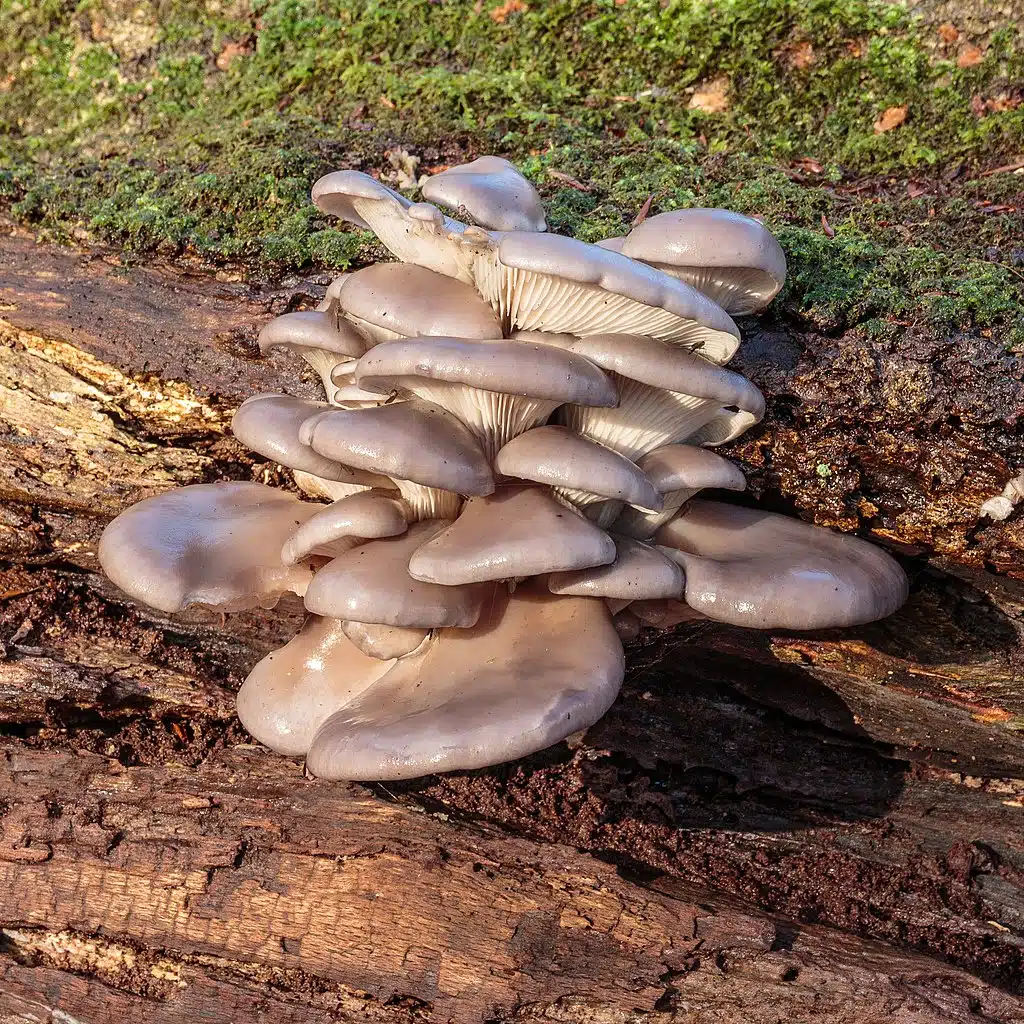
They can naturally be found in woodlands of hardwood trees such as beech and oak or pine and similar trees.
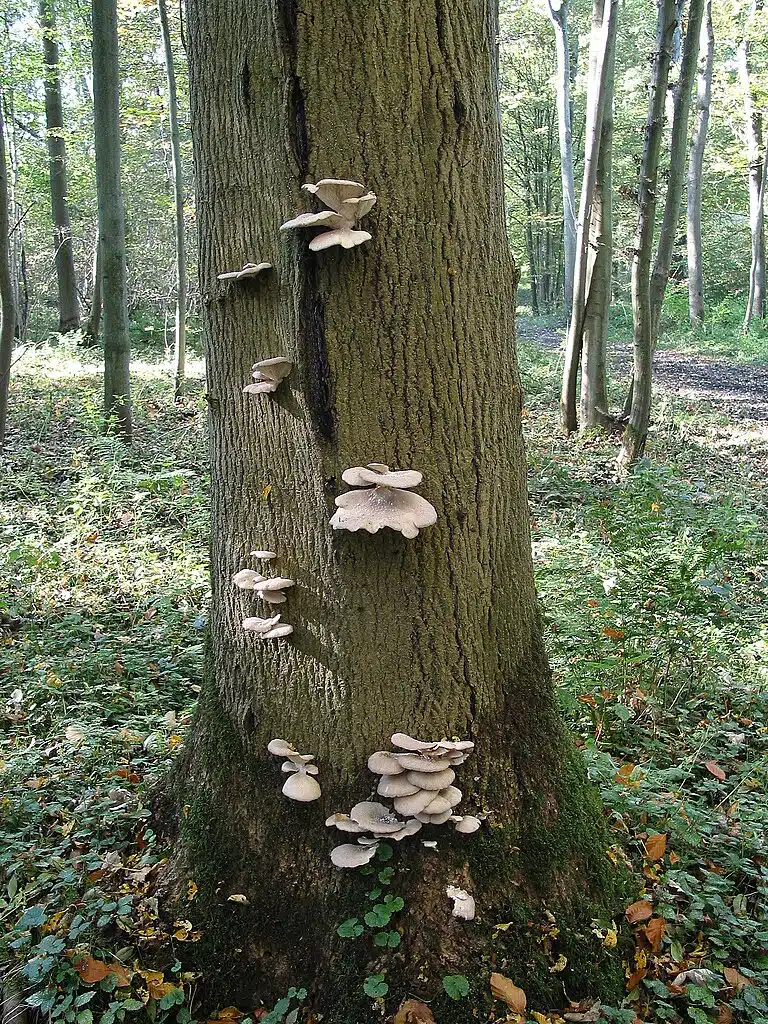
Mushrooms of this species can grow on the lower part of a dying tree or the hard-to-reach upper part of a tree.
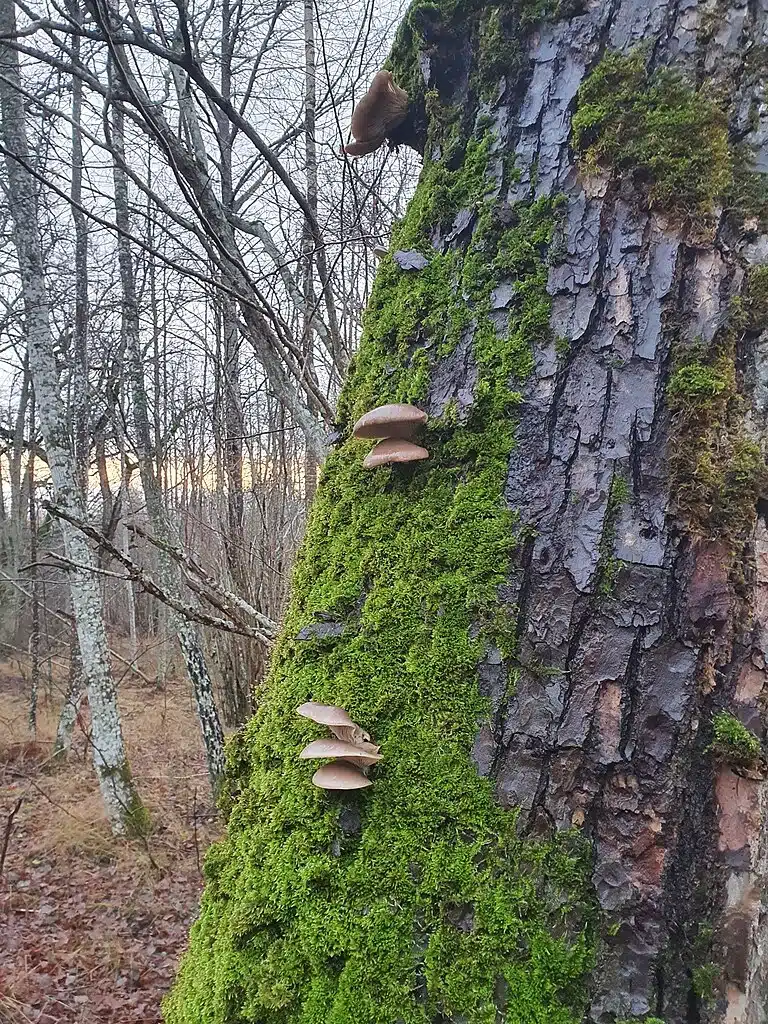
Cap
High variation in cap size is specific to oyster mushrooms. Some of the smaller ones measure 2-4 inches in diameter while some of the larger caps measure 6-10 inches.
Typical cap colors include brown, white, tan, or gray. These caps normally grow in layers, forming small clusters
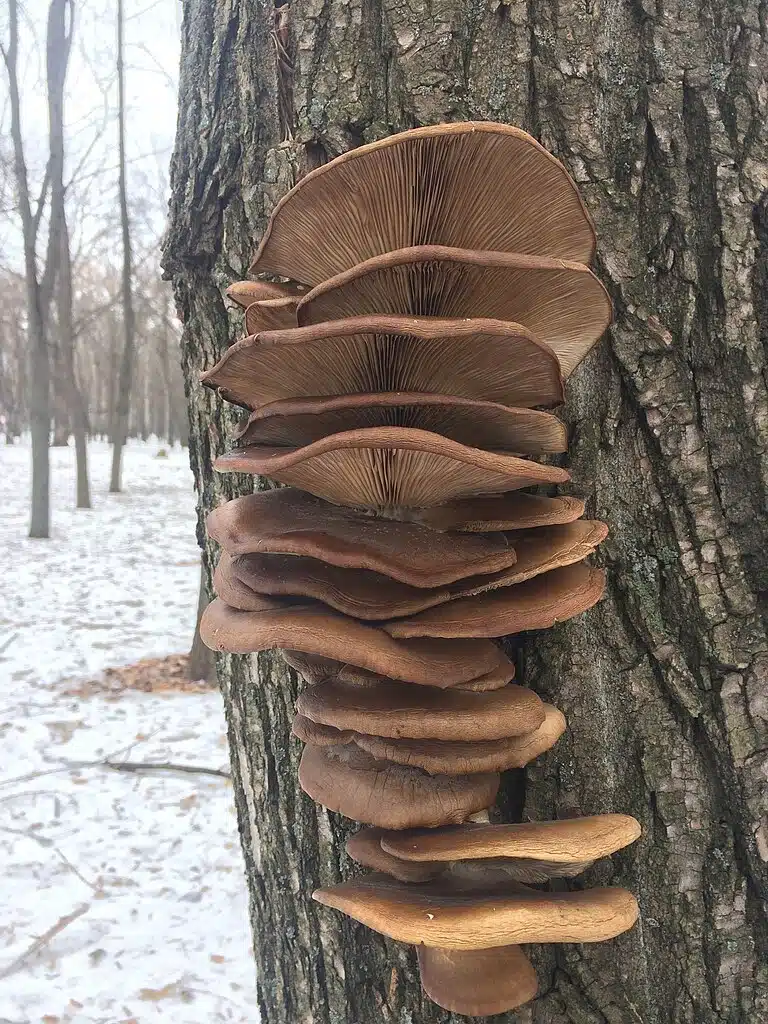
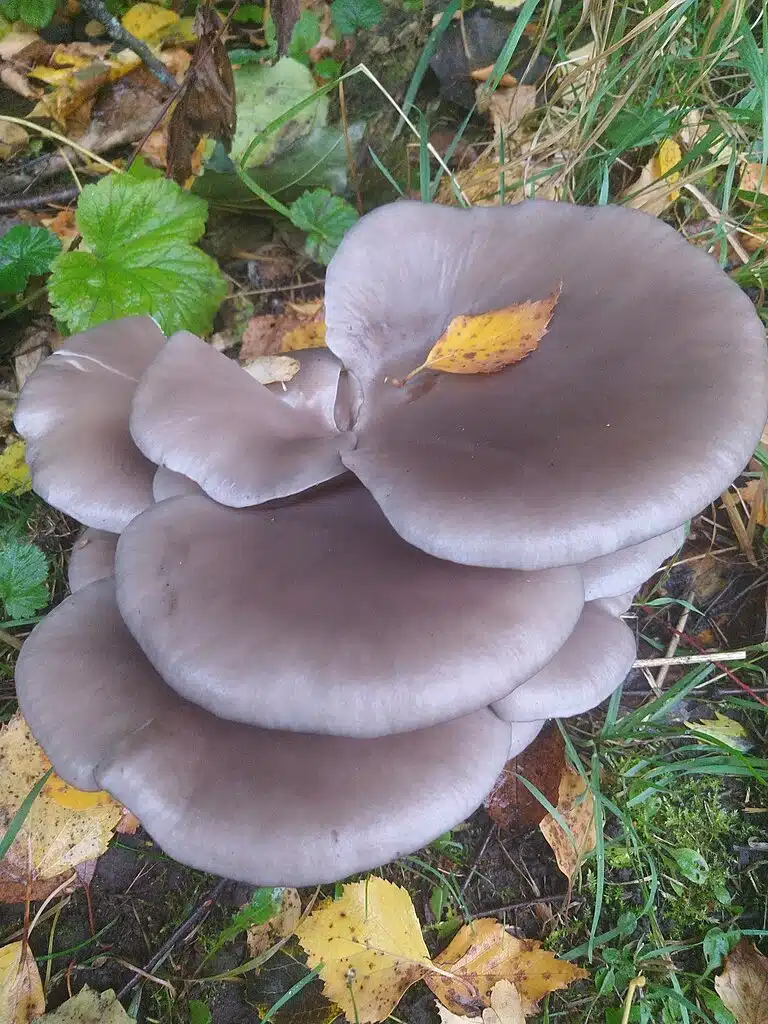
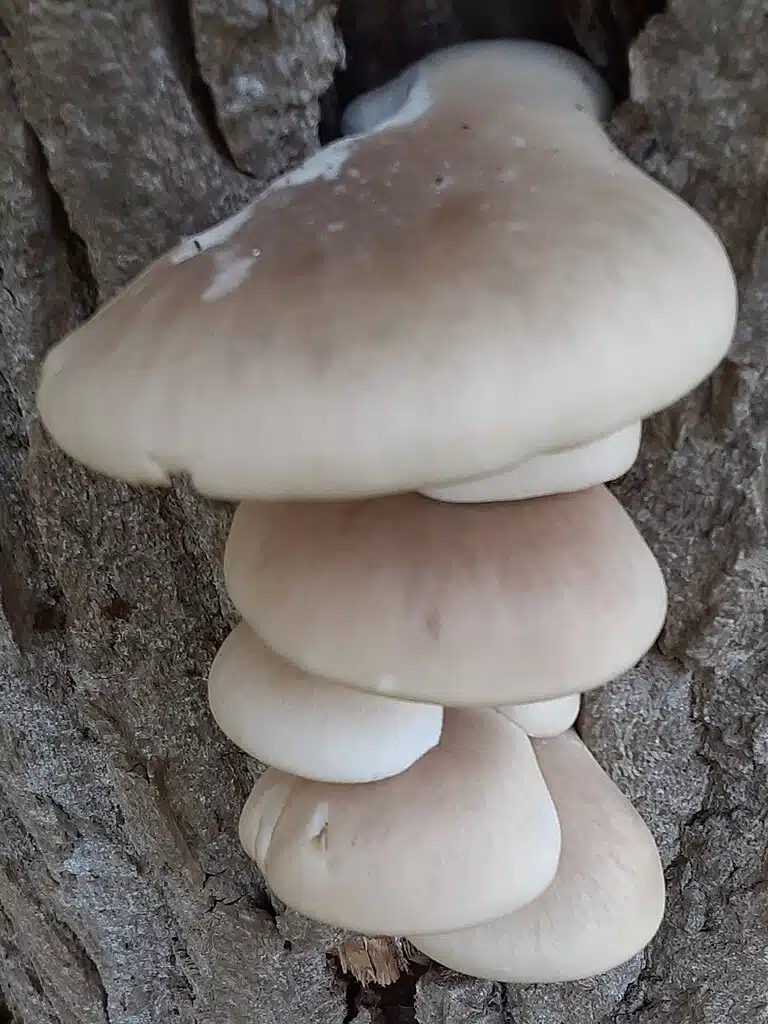
Gills
Most oyster mushrooms show gills that run from the edge of the cap into the stem itself.
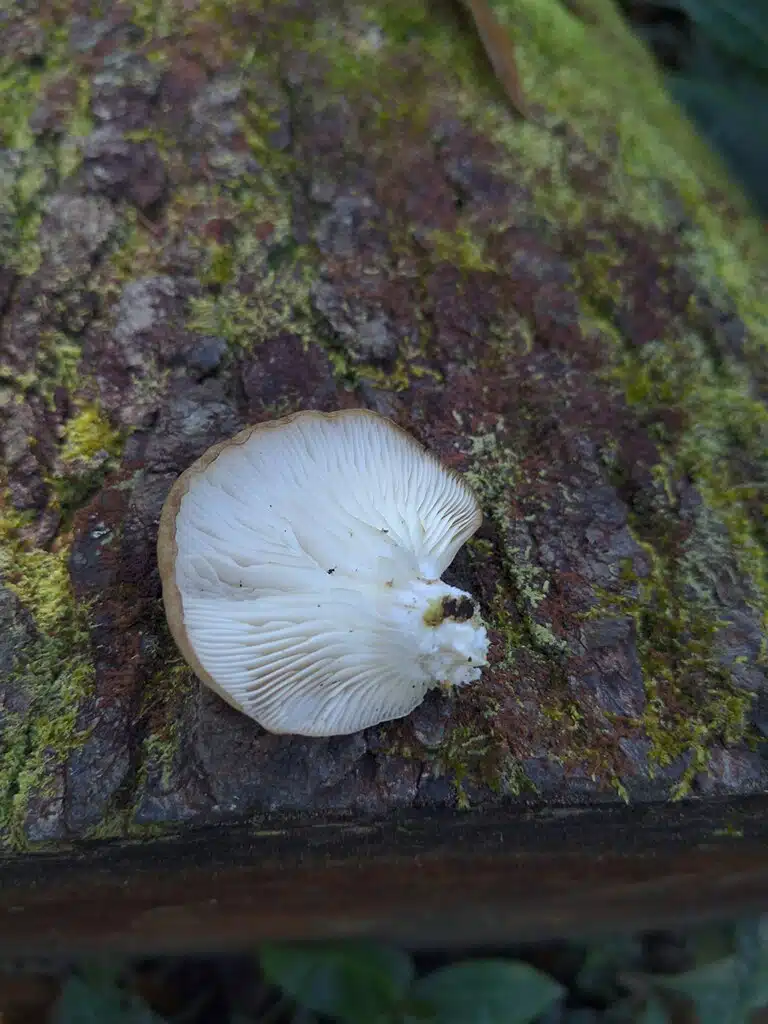
The colors are generally bright. White gills, pale yellow gills, and cream gills are common. Rare colors include dark red and golden yellow gills.
Stem
Not all oyster mushrooms have a stem or a visible stem. Those with a stem typically show a sort of one that connects them to the surface they’re growing on.
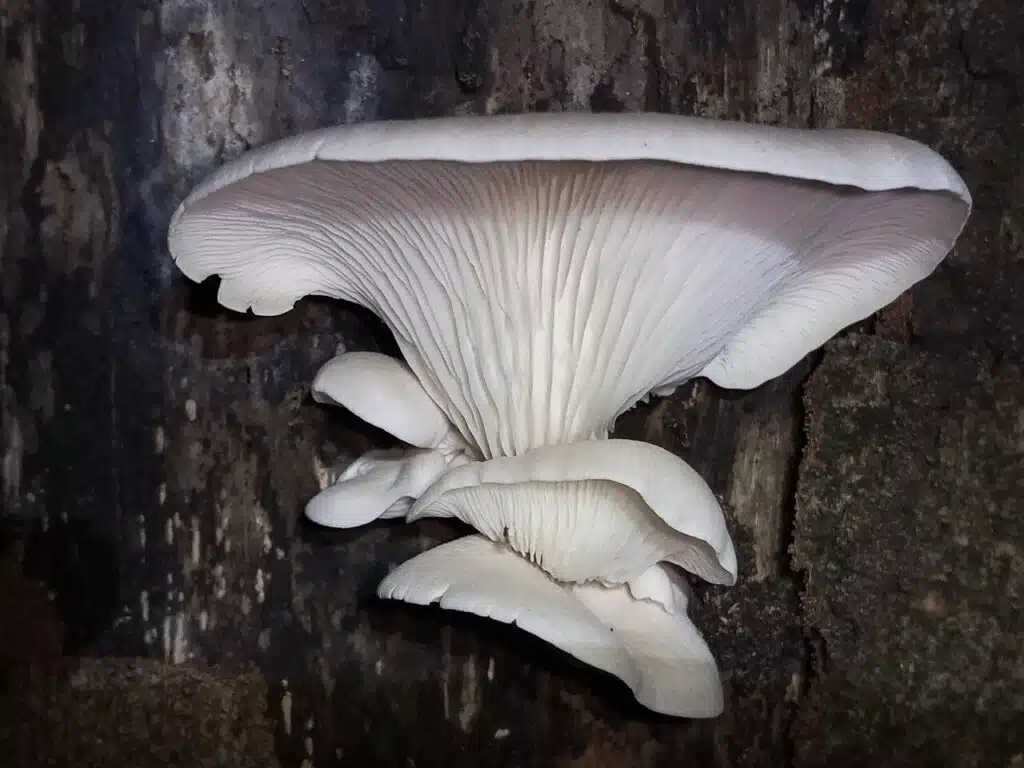
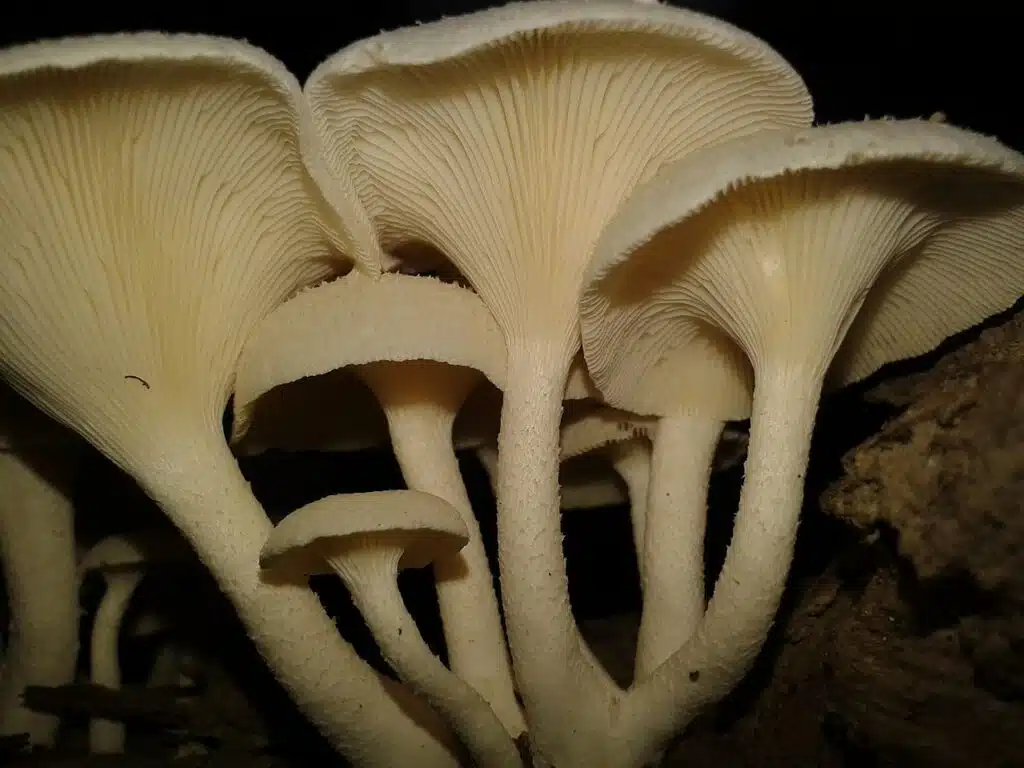
Unlike classic mushroom shapes, oyster mushrooms often have a side stem and not a central stem connected to the cap as they grow attached to wood or another surface.
Spore print
High color variation is specific to the spore print of oyster mushrooms. The white, gray, and yellow spore print is common.
Ecology
Sometimes found on dead wood and dead branches, oyster mushrooms are edible mushrooms that may even be parasitic.
Smell and taste
Oyster mushrooms may seem chewy when raw, but they can be tasty when cooked. They show a mild seafood-like taste and texture. Thin by nature, they cook quickly in the oven and can become crispy when seared.
Flash and bruising
Bruising can be seen in these types of mushrooms. It shows a type of older oyster mushroom that you shouldn’t pick.
Oyster mushrooms that are good to pick and eat should have white flesh.
Time of year
Most oyster mushrooms grow in the summer, fall, or both in the summer and fall months.
Exceptions do apply with fewer species growing in the winter.
Oyster Mushroom Look-Alikes
The following 16 species are the most likely to look like oyster mushrooms.
1. King Trumpet Mushroom
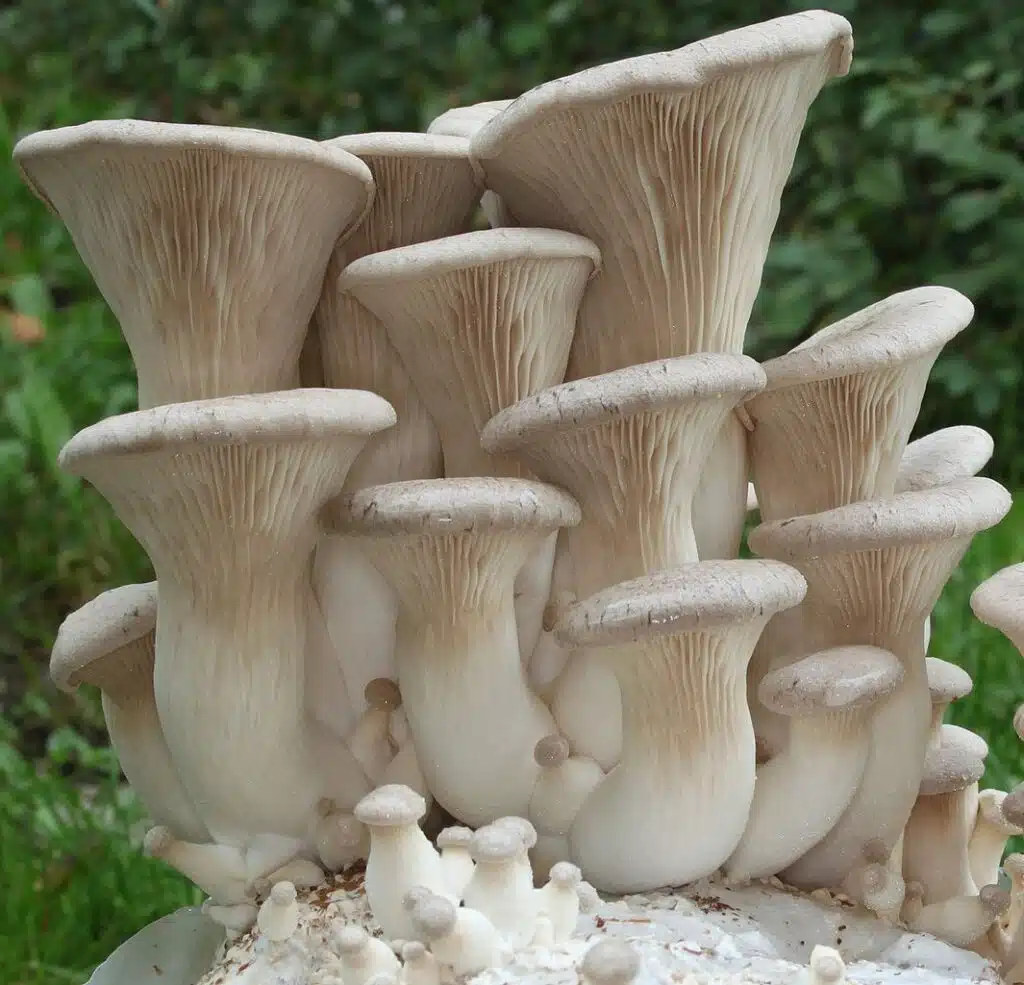
Scientific name: Pleurotus eryngii
Common name: King Oyster Mushroom, aliʻi oyster, French horn
King Trumpet Mushrooms are the largest types of oyster mushrooms also known as Pleurotus.
This is a type of Latin-origin name for a series of mushrooms that look like ears.
Known for its wide stipe and brown cap, this is a species that has that white flesh specific to oyster mushrooms.
King Trumpet Mushrooms are a rare sight in North America but a very common mushroom in Europe.
It grows around The Mediterranean region where it either adds flavor or replaces meat in dishes.
The flavor profile of raw King Trumpet Mushrooms is minimalistic but this changes for the better once cooked.
Most commonly, the taste of these mushrooms is associated with meat taste.
You can find King Trumpet Mushrooms either growing directly on decaying wood or as a type of parasite on the roots of plants.
Both tasty and nutritious, these mushrooms have health benefits for the immune system and are used to add rich flavor to foods such as pasta in Italy.
2. Angel’s Wings
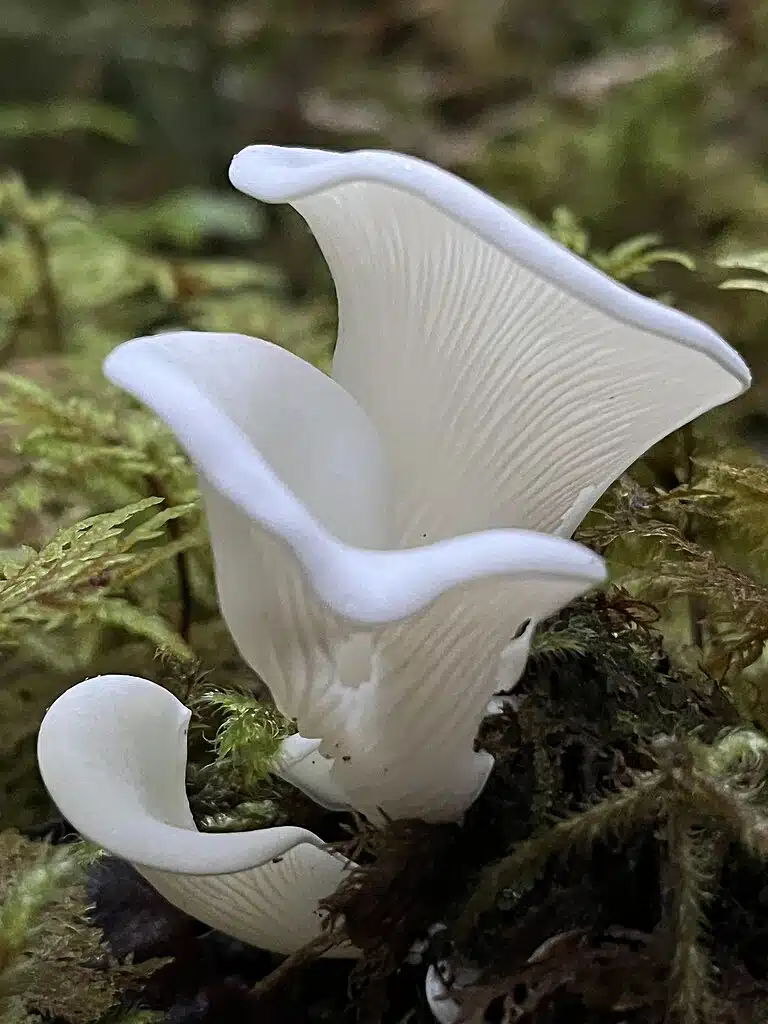
Scientific name: Pleurocybella porrigens
Common name: Angel Wing
Pure white is specific to Angel’s Wings, a type of mushroom that has tall fruit bodies with gills that continue down to the very short and barely visible stem.
White gills and white spores are specific to this bright species.
Much of the history of Angel’s Wings has changed. From a species seen as edible, this is a type of mushroom that isn’t seen as edible anymore.
A few known situations where it caused health problems have steered it away from the group of edible oyster-like mushrooms.
Even worse, Angel’s Wings are tied to human deaths in individuals with pre-existing health issues.
As they grow, these mushrooms can overtake the branch or log they sit on.
Angel’s Wings grow on decaying wood and their presence is sometimes signaled in Japan while they become scarce in other areas around the world.
Spotting them can be easy as they grow in high numbers in a tiered or layered pattern.
3. Shoehorn Oyster
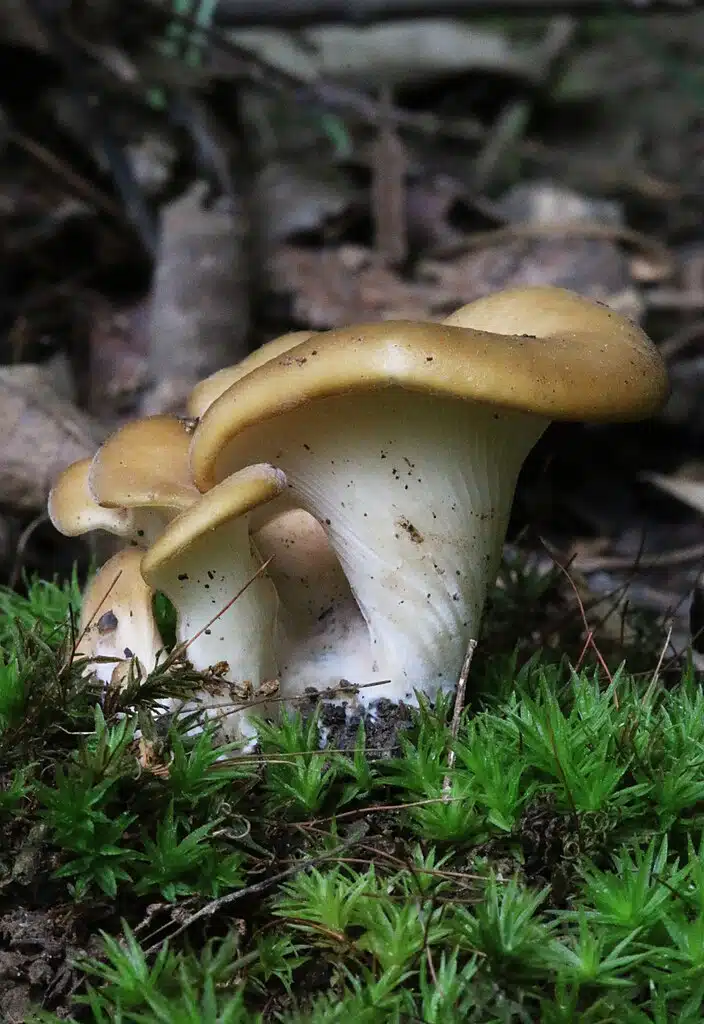
Scientific name: Hohenbuehelia petaloides
Common name: Leaflike Oyster
Also quite rare, Shoehorn Oyster mushrooms do look like proper oyster mushrooms.
They feature brown nuances on the cap. From pale brown to dark brown, there are various shades the mushrooms are described in.
White and gray gills are specific to this species which shows white print spores.
The stipe of the mushrooms is white, short, and off-centered.
As edible mushrooms, Shoehorn Oysters may be collected as they grow in clusters. All of them grow on well-decaying wood around the world.
Maximum growth stages don’t come with any taste-related benefits.
You may collect the mushrooms when the cap is the largest which is around 3-5 inches in diameter.
The season of the mushrooms is also specific to many oyster-like species. First appearance in June, they can be collected up to September.
4. Stinking Orange Oyster
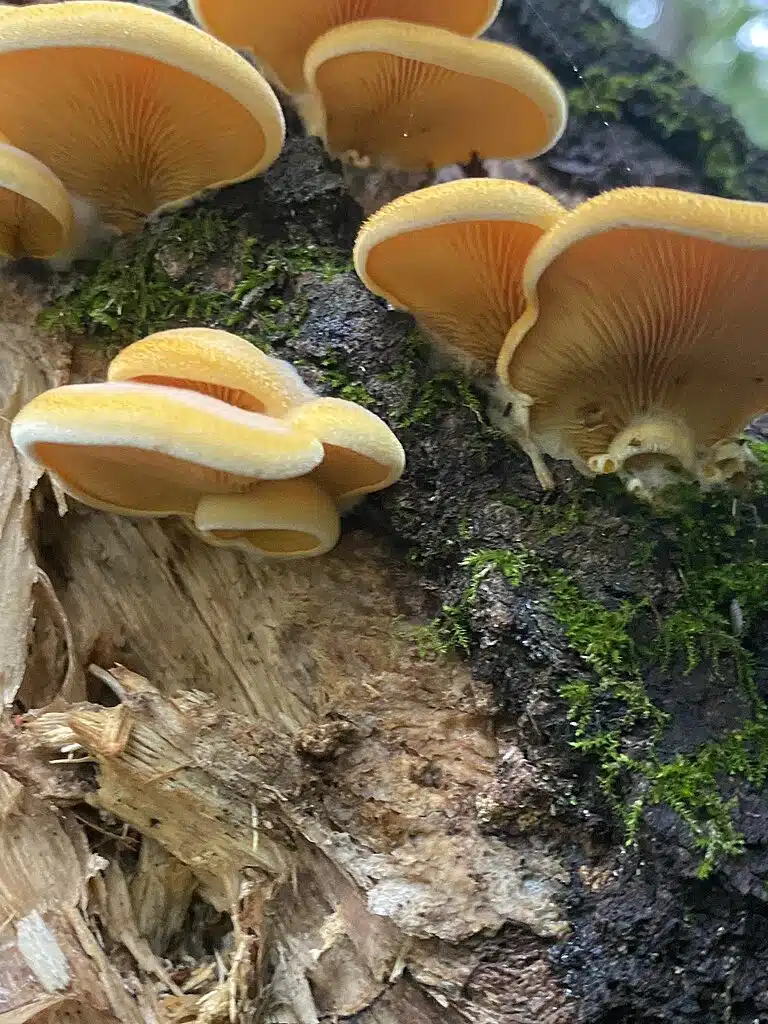
Scientific name: Phyllotopsis nidulans
Common name: Mock Oyster, Orange Oyster.
Stinking Orange Oysters are mildly orange. A pale orange nuance is specific to these types of mushrooms that only grow on decaying wood.
A small pebble-shaped fruiting body is characteristic of Stinking Orange Oysters.
Once growing in clusters, its pungent smell is also very noticeable. These mushrooms smell bad but they don’t kill those who eat them regardless of the smell.
There’s no visible stipe while the pink spots seen on them represent the spores.
Very fine orange gills are also visible on the species.
Stinking Orange Oysters are rarely large compared to other oyster-like species. They may reach a 3-inch cap, but only in the maximum growth stage.
Furthermore, these mushrooms may be confused with other species as they mostly have a yellow color at first, slowly, darkening as they grow.
Some of the forests they grow in are found in North America, from the West to the East Coast.
5. Ghost Fungus
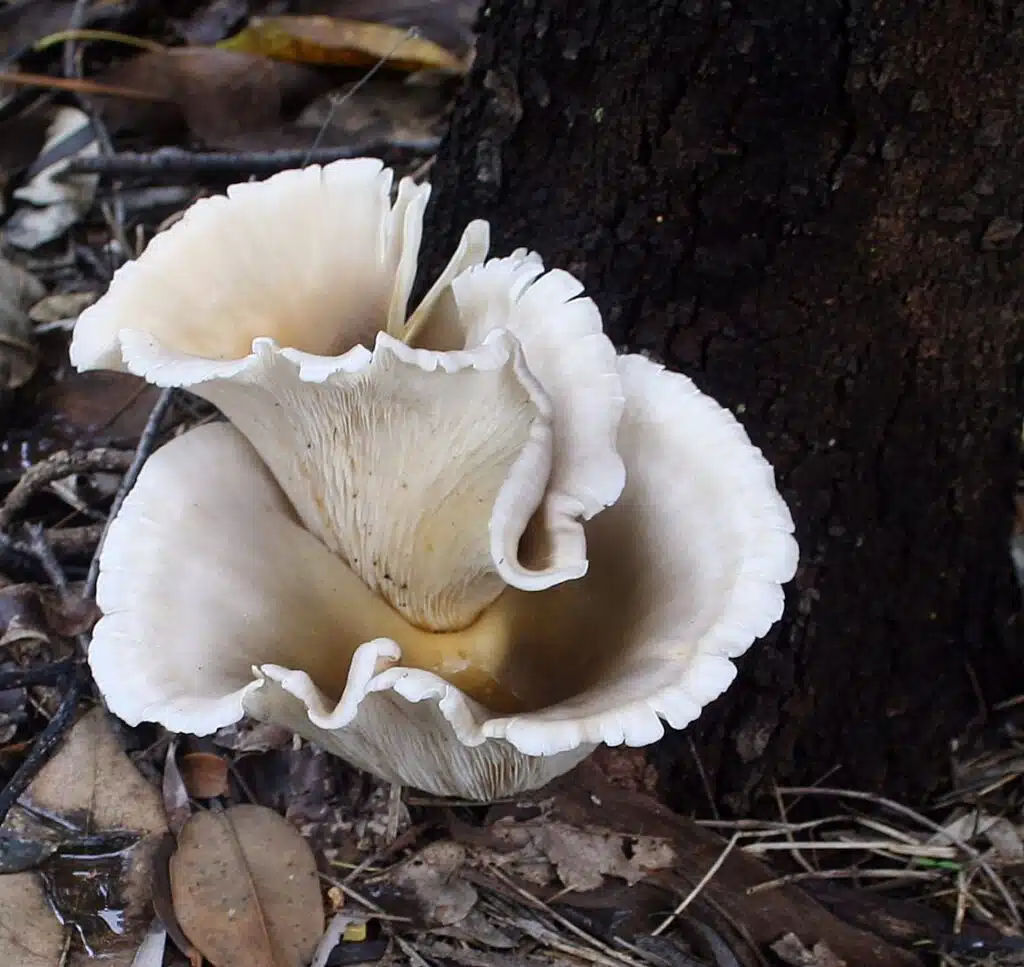
Scientific name: Omphalotus nidiformis
Common name: Ghost Fungus
The almost pure white color of these mushrooms inspires their name.
While white, the nuance of the fruit body is slightly darker, closer to cream. Darker variations of these mushrooms also exist, which makes correct identification harder.
Ghost Fungi can also have a darker gray cap with cream-yellow margins.
A gray and brown central area with white margins may also be a variant spotted on some dying trees.
In all variations, the gills and the short off-center stipe remain white.
This is a species that grows in Australia and neighboring countries and which may be seen as a parasitic type of oyster mushroom look alike.
It grows on dead trees but it also becomes a parasite of a dying tree.
These fungi are poisonous and shouldn’t be picked. While not deadly, they lead to continuous vomiting which may last up to a day after eating.
6. Western Jack-O’-Lantern
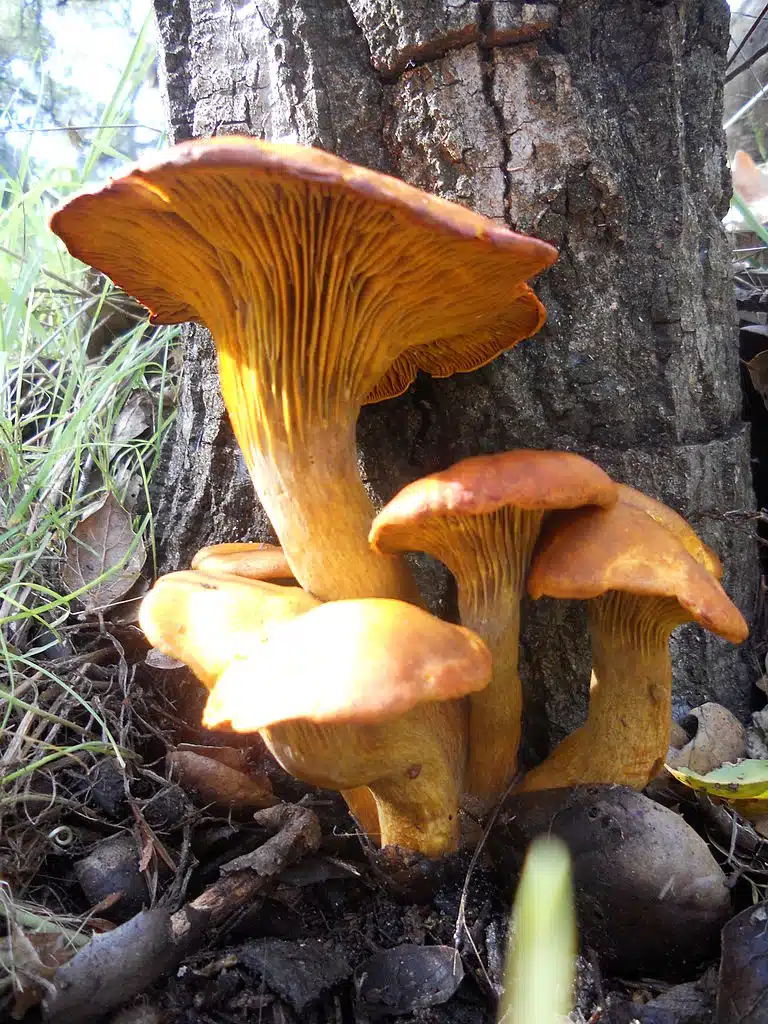
Scientific name: Omphalotus olivascens
Common name: Western Jack-O’-Lantern
Vivid yellow colors are specific to Western Jack-O’-Lantern mushrooms.
Shaped as an oyster, they show a brighter nuance on the yellow gills which come down to the stipe.
Some of the distinct traits of the species include a darker golden margin on the cap with a more yellow-inclined nuance towards the center.
This is a species with a consistent presence in California woodlands where they grow on various trees.
Their role in the ecosystem is to help break down decaying wood but these mushrooms are highly poisonous.
Found on decaying hardwood or buried hardwood, Western Jack-O’-Lantern mushrooms show yellow spores and shouldn’t be eaten even in small amounts as they cause severe cramps and vomiting.
If they manage to grow large on old and well-decaying wood, these mushrooms are also some of the largest, reaching a size of up to 7 inches.
7. Ivory Funnel
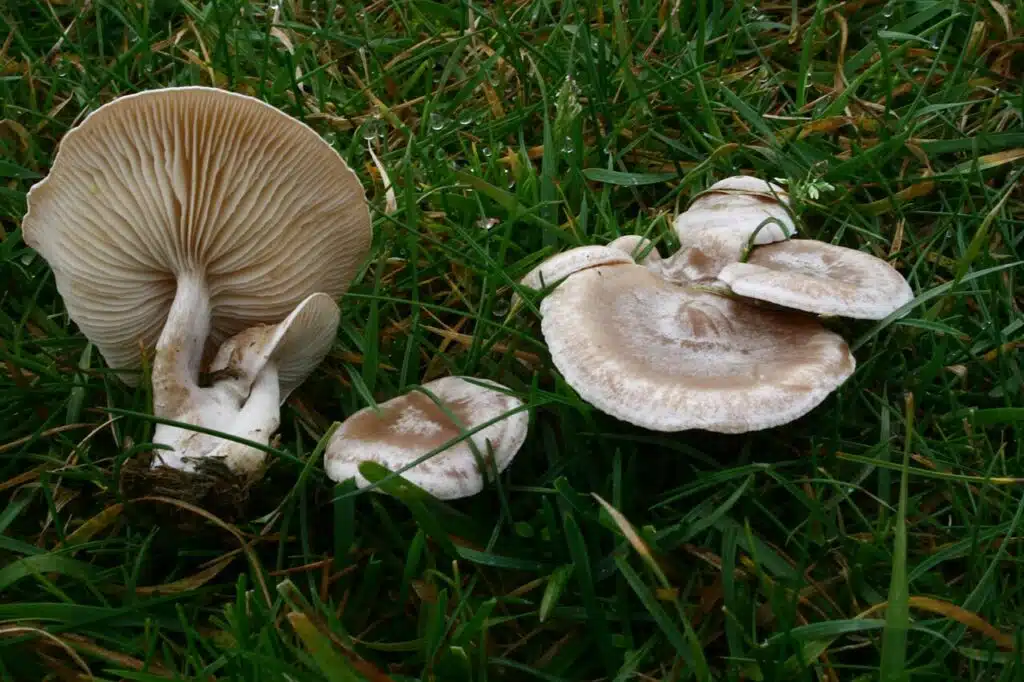
Scientific name: Clitocybe dealbata
Common name: Sweating Mushroom, Ivory Funnel
Some species like oyster mushrooms have a late season in their temperate climates.
Ivory Funnel mushrooms may as well be some of the species that grow in December, into the winter.
They are found in Northern European and North American climates.
Ivory Funnel mushrooms have an ivory-white nuance of the cap, gills, spores, and stipe.
They remain rather small, rarely reaching a diameter of 3 inches.
A long season and the capacity to grow in woodlands with other edible species may confuse mushroom pickers.
A bright appearance may make these mushrooms look friendly and tasty by they are deadly.
While they don’t kill all those who eat them, the mushrooms cause severe reactions such as vomiting, sweating, and even heart issues.
One way to identify them correctly is to check if they grow in fairy rings. This is a type of circular growing pattern that may or may not be specific to all Ivory Funnel mushrooms.
8. Golden Oyster Mushroom
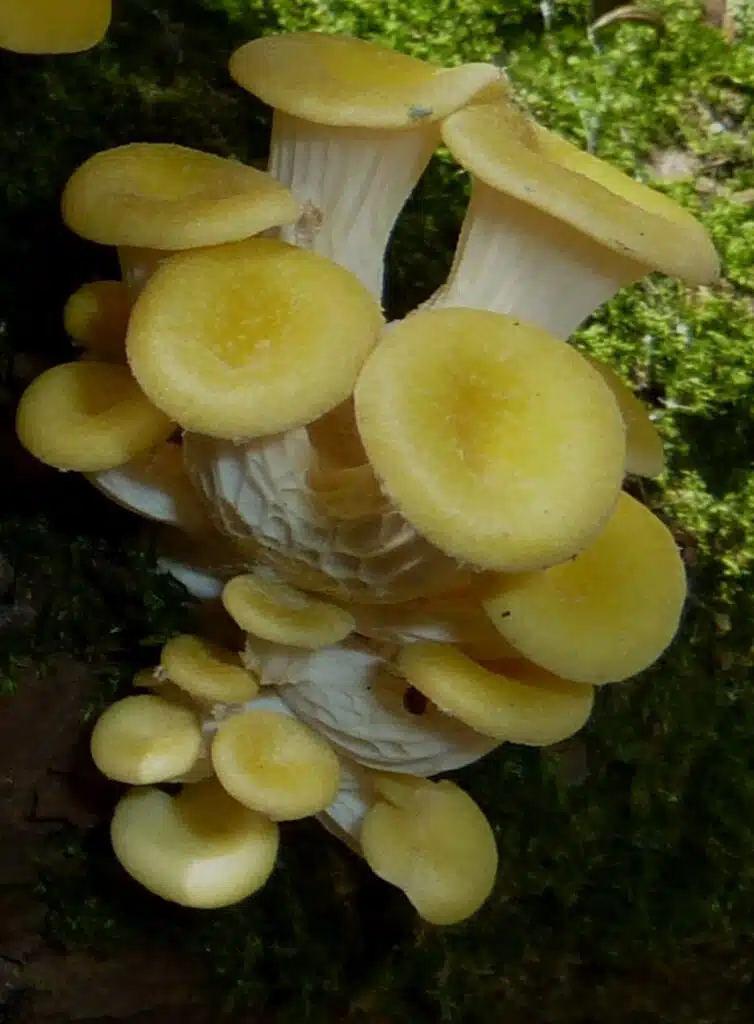
Scientific name: Pleurotus citrinopileatus
Common name: Golden Oystern Mushroom
A species of Japan, Golden Oyster Mushrooms are named after the bright golden color caps, which are rarely brown.
Apart from a golden nuance, the caps of these mushrooms are also waxy.
A thick white stipe with gills coming down to the bottom is seen on Golden Oyster Mushrooms.
Popular in cuisine around the world, Golden Oyster Mushrooms can be collected.
They are commercially grown almost more than any other type of oyster mushroom in countries such as China as they can grow directly on sawdust.
High availability and a quick growth rate don’t mean Golden Oyster Mushrooms lack true nutritional value.
They come with a high concentration of antioxidants with known health benefits.
Once cooked, these mushrooms are also highly aromatic, elevating a range of dishes. This aroma is not present in raw Golden Oyster Mushrooms
9. Aspen Oyster Mushroom
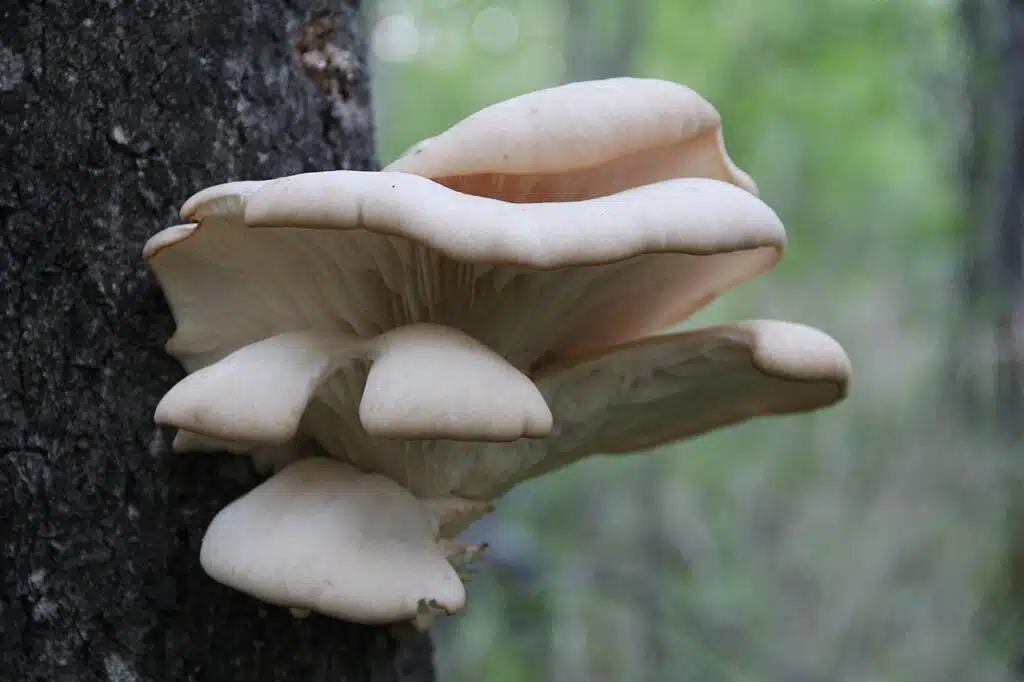
Scientific name: Pleurotus populinus
Common name: Aspen Oyster Mushroom
As one of the largest and most common types of oyster mushrooms in North America, this species is found at higher elevations in The US and Canada.
It prefers deciduous woodlands of aspen and black cottonwood and it only grows on this decaying wood and sometimes on dying aspen.
Colors can vary on the species but are generally bright.
From white to cream and even pale yellow nuances, Aspen Oyster Mushrooms can be quite considerable with a cap that may grow to a size of over 7 inches.
Growing in layers, these types of oyster mushroom look-alikes have a thicker cap than others and grow in a layered pattern.
A short season is specific to these mushrooms. Aspen Oyster Mushrooms only grow from the beginning of the summer to mid-summer.
10. Summer Oyster Mushroom
Scientific name: Pleurotus pulmonarius
Common name: Indian Oyster, Italian Oyster, Lung Oyster, Phoenix Mushroom
This species of mushroom is one of the most cultivated in the world.
Summer Oyster Mushrooms come under a range of different names given their popularity. The pumonarious term of their scientific names is found in its Lung Oyster alternative common name.,
A range of bright colors, including white and tan, are specific to Summer Oyster Mushrooms.
Largely grown for retail in Europe, these mushrooms also grow in North America.
Depending on the region, they may grow on hardwood trees or on coniferous trees.
They grow both on dead and on living wood and are expected to get highly popular in North American dishes as well.
A maximum cap size of 3.9 inches is specific to the species that tends to grow either in clusters or individually.
Many health benefits and potential health benefits are associated with their compounds.
Summer Oyster Mushrooms may help the reduction of excessive sneezing in humans as this has already been proven in lab tests.
The consumption of these mushrooms may also have benefits in slowing down cancer spread.
A mild taste is specific to Summer Oyster Mushrooms which has been compared to the taste of anise.
11. Veiled Oyster
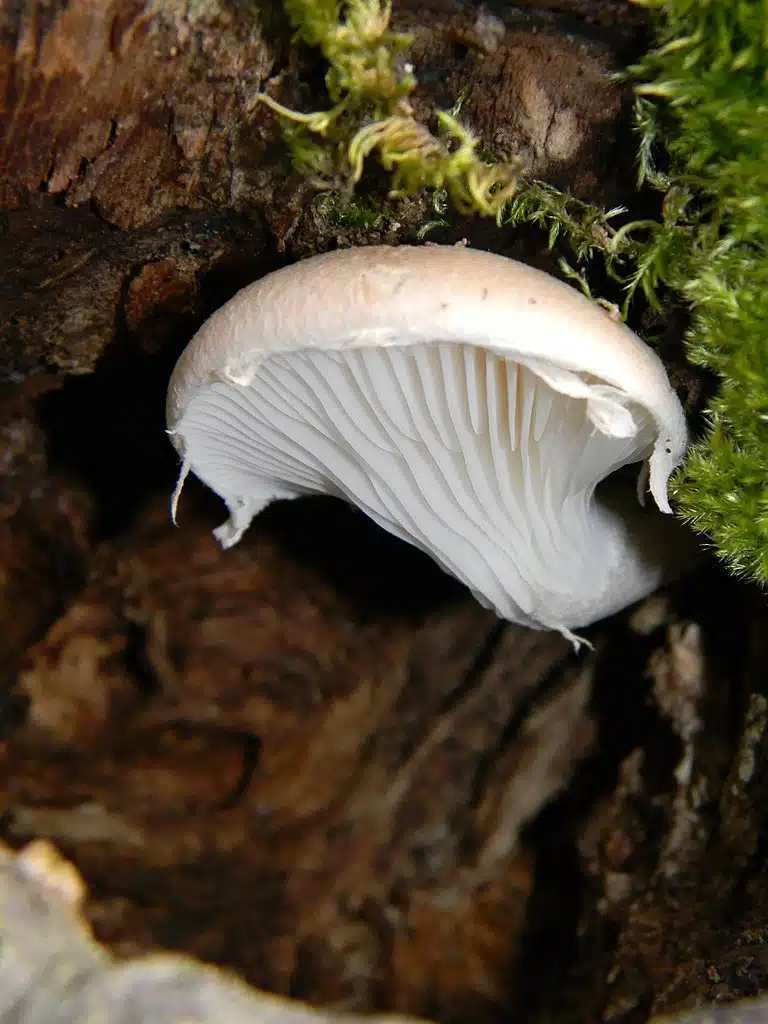
Scientific name: Pleurotus dryinus
Common name: Veiled Oyster
The convex shape of the cap stands out on Veiled Oysters. These are some of the brightest mushrooms with white dominating their appearance, together with cream and off-white.
The cap and gills are white and as expected, the white gills come down the white stipe.
Growing up to a size of 3 inches, the cap tends to be white at first with some room to become yellowing as it expands.
Growth patterns are specific to oak woodlands, beech, and even various pine trees.
These mushrooms show parasitic growing patterns on living trees but they also grow on dead oak trees.
Harvesting them is rather difficult as they aren’t the most common.
While edible, Veiled Oysters don’t represent a culinary feast as they become rubber-like as they get older and they may only be picked when young.
12. Late Oyster

Scientific name: Sarcomyxa serotina
Common name: Late Oyster, Late Fall Oyster
A species shaped like a kidney with an off-center stipe, Late Oysters go through considerable appearance changes as they grow.
These types of mushrooms show a brighter color, then a dark color, then a bright brown final color.
Mostly cream at first, the species is known for its intermediary dark olive color which is rare in these types of mushrooms that grow on dead trees.
Even more, Late Pyster tends to become shiny and slimy when it rains. Their gills are bright brown and their final color as they become older is also brown.
Growing in pine and hardwood, Late Oysters are named after their delayed growing patterns.
Still, they aren’t as common as other late-season oyster mushrooms.
Late Oysters have also long been believed to be edible albeit there’s conflicting evidence in regards to their edibility.
Potentially linked to compounds that may cause cancer, these mushrooms should be avoided.
13. Branching Oyster
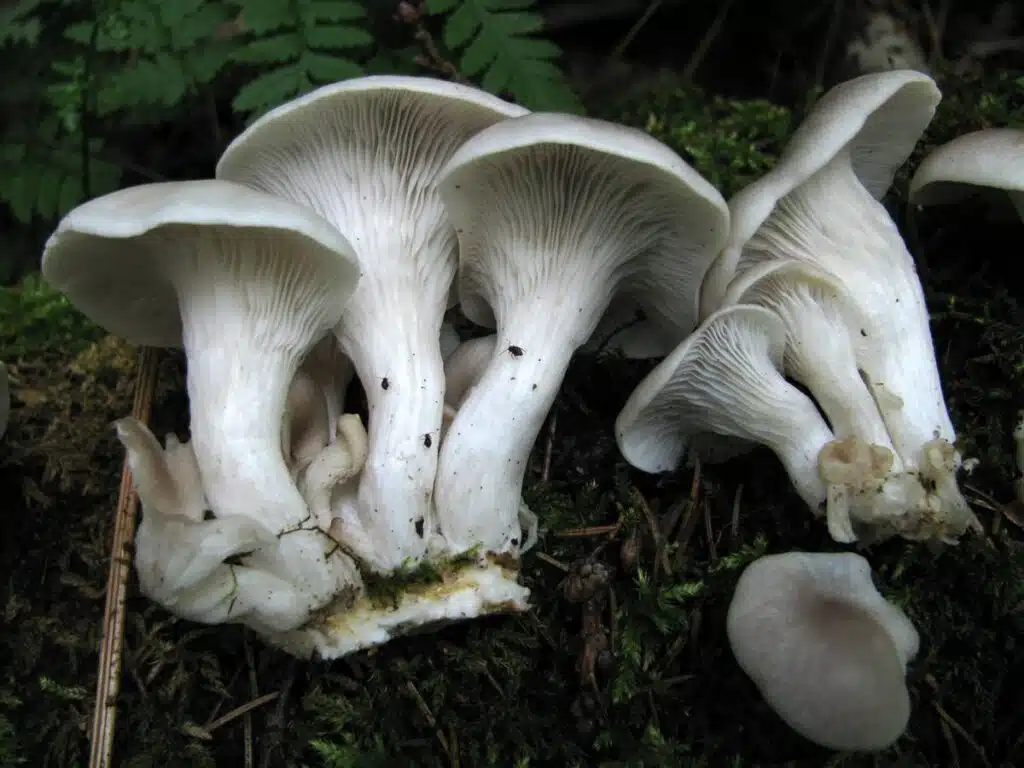
Scientific name: Pleurotus cornucopiae
Common name: Branching Oyster
Branching Oysters are mostly common due to their edibility and good taste. A powdery or flour-like taste is specific to these mushrooms which are recommended for stir-frying.
Mostly sold in China and Europe, these mushrooms are on trees. They can even become a small parasite of hardwood trees.
Initially all-white, they become pale yellow on the cap as they grow.
The stipe is white and may be off-center or centrally-located with gills running down to the bottom.
Growing in the summer, the mushroom is picked at various growth stages. Its mild taste isn’t specifically influenced by its picking period.
Branching Oysters naturally grow on trees and logs throughout the summer and into early fall.
While rare in North America, they can grow on elm.
14. Brown Oyster Mushroom
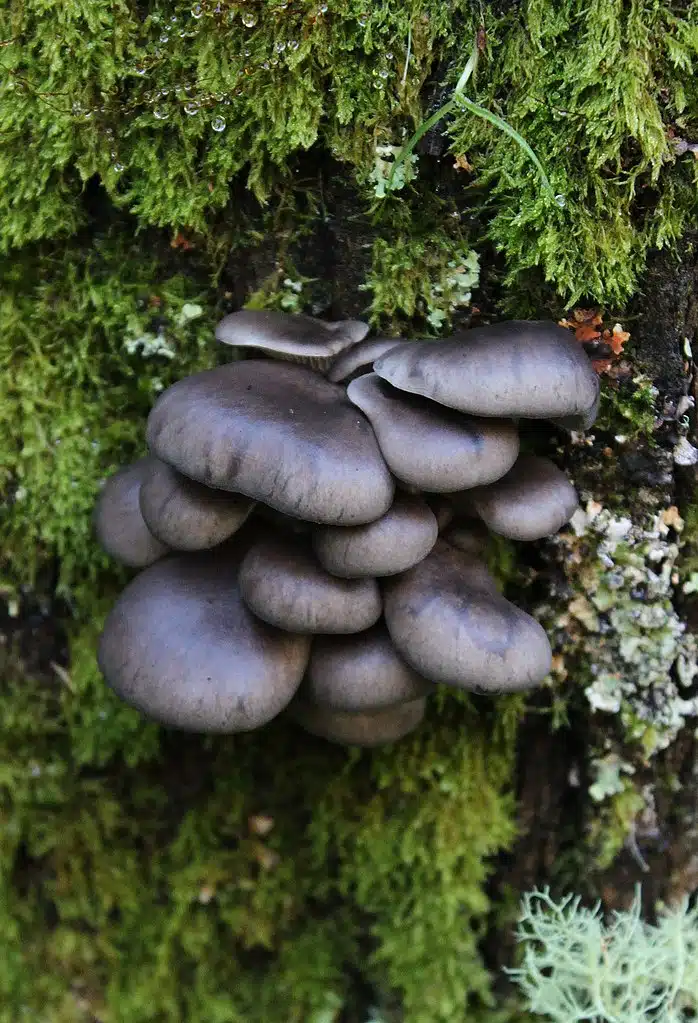
Scientific name: Pleurotus australis
Common name: Brown Mushroom, Brown Australian Oyster Mushroom
A species dominated by bright and dark brown nuances, Brown Oyster Mushrooms mostly grow in Australia and New Zealand.
These mushrooms are eaten locally. Their taste is mild and not specifically memorable.
A large cap and their local availability make them a constant presence in retail.
Brown Oyster Mushrooms are present in stores during the summer as they only grow in warm weather.
Associated with kanuka trees, the mushrooms may grow singly or in clusters.
They also grow on logs or dead trees shortly after they die.
They tend to darken considerably with age. The initial bright brown cap becomes dark brown close to black in the center with brighter brown margins as the cap grows.
15. Pink Oyster Mushroom
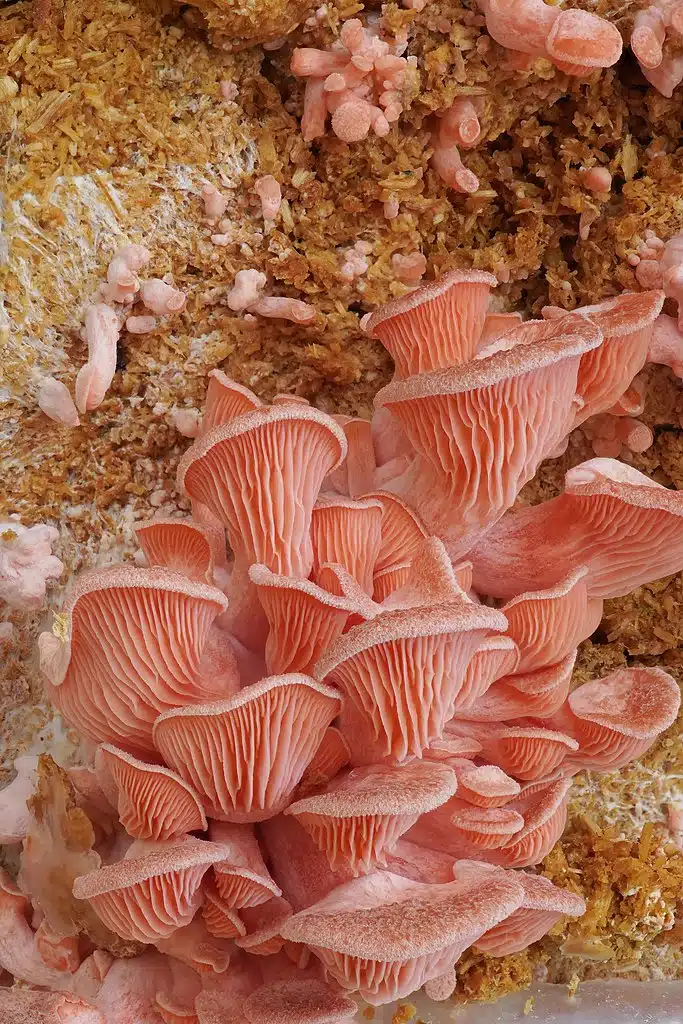
Scientific name: Pleurotus djamor
Common name: Pink Oyster Mushroom, Seta, Hongo de Pino
This oyster-shaped mushroom is known for its very distinct taste and its pink-red nuance.
Brighter nuances are seen on its gills. From bright to vivid pink, the gills tend to darken as the cap expands.
Growing on dead trees, it’s also one of the most popular species for mushroom growers to consider for sawdust.
The mushrooms are now eaten around the world due to their rich flavor profile.
A meat-like taste or a bacon-like taste are among the most common references when it comes to describing the high aromatic profile of Pink Oyster Mushrooms.
Quite small even when the cap is the largest, these mushrooms grow to a maximum diameter between 1 and 2 inches.
A common species in The Americas, particularly in Mexico, this oyster mushroom grows from late spring to late fall.
It can be picked from hardwood trees and especially from pine trees.
16. Lynx Paw Oyster
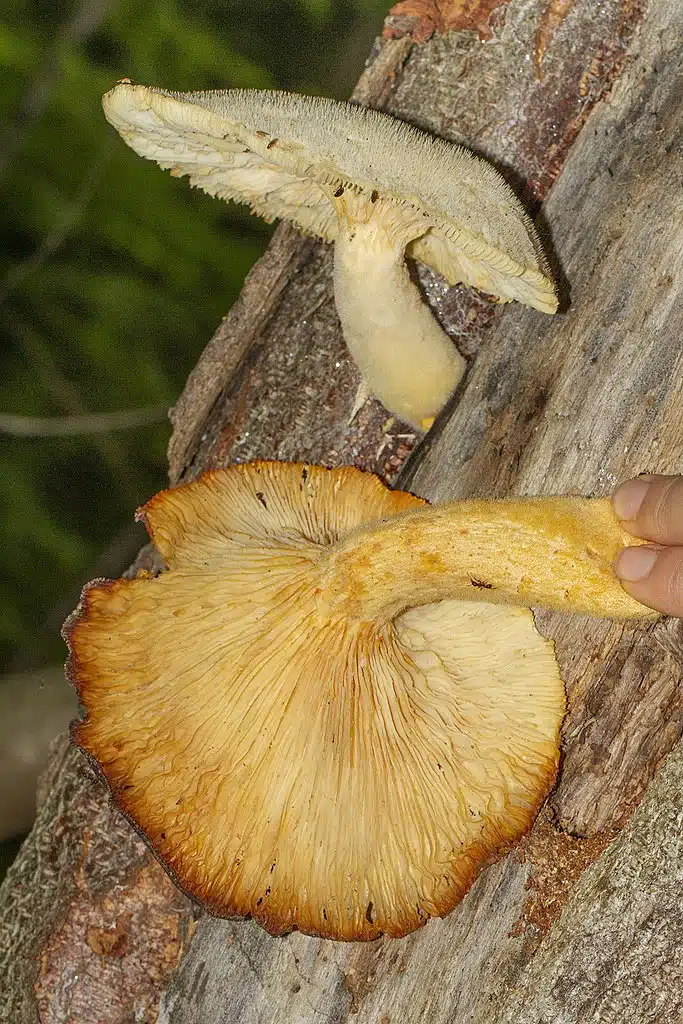
Scientific name: Pleurotus levis
Common name: Giant Panus, Lyns Paw Oyster
A mostly white type of oyster mushroom, Lynx Paw Oysters are among the species that grow on both living and dead trees.
They can be spotted on the wounded area of a tree in higher numbers but they tend to become even more numerous on logs.
Initially white-capped, they become slightly cream or yellow-colored afterwards, as they grow.
Their gills remain purely white throughout the growth stages.
Yellow cap stages are different for the species but most yellow nuances are specific to the edges of the cap. Additional brown and black spots are distinguished on the cap.
Lynx Paw Oysters show a white stem with similar white spores.
Rarely collected as they can even grow high up on trees, these oyster mushrooms are a rare sight.
The edibility of the mushrooms is believed not to be of great importance. While they can be eaten, they are too chewy to be considered a popular oyster mushroom species.